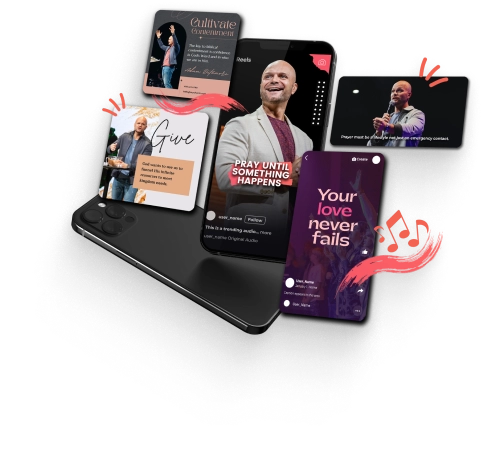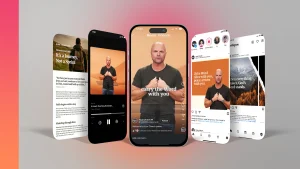Imagine having every sermon at your fingertips, ready to inspire and guide you. A digital sermon library makes all this possible, offering access from any device. It’s not just tech-savvy; it’s practical for everyone. Whether you’re revisiting a favorite message or catching up on last Sunday’s teaching, a sermon library can support your spiritual journey. This online resource ensures no sermon is out of reach, bridging distances and busy schedules. By the end of this post, you’ll see how a sermon library can enrich your life. Ready to bring sermons closer? Let’s see how it works.
Understanding the Importance of a Digital Sermon Library
A digital sermon library isn’t just about storing sermons. It’s a transformative tool for churches and congregations. Imagine a world where anyone, anywhere, can access your church’s teachings at the click of a button. That’s the power of a sermon library. Let’s explore why this is essential for today’s faith communities.
Accessibility for Diverse Audiences
Not everyone can be at church every Sunday. But with a digital sermon library, distance is no longer a barrier. People who are homebound, traveling, or living far away can all feel connected. It’s like removing the walls of your church and inviting the world inside.
Think of it like offering an open door to those who can’t attend in person. This accessibility ensures that every person, regardless of circumstance, can engage with your sermons.
Preserving Sermons for Future Generations
Sermons are more than just weekly talks; they’re a record of your church’s spiritual journey. By archiving them, you’re building a legacy. This isn’t just for nostalgia—it’s for education, study, and inspiration.
Imagine a library filled with not just books but also the voices of pastors in the past. Future generations can learn from these messages, drawing wisdom from them as they navigate their own spiritual paths. A sermon library becomes a time capsule, preserving your church’s history for the ages.
Enhancing Engagement and Outreach
Creating a sermon library isn’t just about maintaining a record. It’s a tool to drive engagement and reach new audiences. How do you bring more people into your community without them stepping foot in your building? You share your message far and wide.
Attract new members: A digital library can serve as a gateway for newcomers, showcasing your church’s values and teachings.
Keep current members engaged: Regular attendees can revisit sermons to deepen their understanding or catch up if they’ve missed something.
Whether it’s someone seeking a new church home or a curious visitor, a sermon library offers a taste of what your congregation has to offer. It turns your local ministry into a global outreach program, opening the doors to anyone curious enough to click.
Key Features of an Effective Sermon Library
Creating an effective sermon library involves more than just uploading sermons online. To truly engage users, a sermon library must be thoughtfully designed, ensuring easy access and a rich experience across all platforms. Let’s explore some of the key features that can transform a sermon library into an indispensable resource.
User-Friendly Interface
Think about the first time you enter a new building. If signage is clear and paths are intuitive, you feel welcomed and at ease. A sermon library should evoke the same feeling. An intuitive design ensures that users can navigate the library effortlessly. When users can find what they need without frustration, they’ll be more inclined to return again and again.
Multimedia Integration
A sermon isn’t just about words. It’s an immersive experience that often involves audio, video, and text. By integrating these media types, you can offer a richer experience. It’s like giving users a front-row seat every time they click play. Whether someone prefers watching or listening, a comprehensive library caters to all preferences, making each sermon as impactful as being there in person.
Search and Filter Functionality
When users flock to a sermon library, they often know what they’re looking for. That’s why powerful search and filter options are essential. Users should be able to find sermons by topic, date, or speaker easily. Think of it as providing a map to someone entering an unfamiliar city. The quicker and more reliably they can get to their destination, the better their experience will be.
Mobile Compatibility
Gone are the days when people consumed content solely at their desks. Today, it’s all about being on the go. Ensuring your sermon library is compatible with smartphones and tablets is crucial. It’s like ensuring a book fits into a backpack, ready for a journey. Your audience should be able to access sermons wherever they are, without any hiccups.
Social Sharing Options
People love sharing inspiring content with friends and family. Implementing social sharing features means your sermons can reach further than just your congregation. It’s like encouraging everyone to bring a friend to church. By making it easy to share, you increase the chances of your message touching more lives, spreading positivity and engagement across social media platforms.
An effective sermon library isn’t just a storage space; it’s a dynamic hub that meets the needs of modern users. By focusing on these key features, you create a library that’s as engaging as it is useful, ensuring your sermons have the widest reach possible.
Choosing the Right Platform for Your Sermon Library
Selecting the right platform for your sermon library is crucial to making sermons accessible and impactful. Whether your church is large or small, finding a solution that fits your needs without straining your resources is key. The right platform can make it easier to store, share, and manage sermons. Let’s look at some factors that can guide your decision.
Self-Hosted vs. Cloud-Based Solutions
When choosing a sermon library platform, you can typically choose between self-hosted and cloud-based solutions. Each option has its own set of benefits and drawbacks.
Self-Hosted Solutions:
Pros:
Control: You have full control over the data and customization.
Security: It offers more robust security since you can manage it directly.
Cons:
Maintenance: Requires technical skills to manage and update.
Cost: Potentially higher initial setup costs for hardware and software.
Cloud-Based Solutions:
Pros:
Ease of Use: Often user-friendly and requires less technical expertise.
Convenience: Accessible from anywhere with an internet connection.
Cons:
Dependence on the Internet: Requires reliable internet access.
Recurring Costs: Subscription fees can add up over time.
Choosing between the two often comes down to your church’s technical capabilities and budget.
Cost Considerations
Budget is always a concern, but choosing the cheapest option may not always be the best. You should weigh the costs against the features and benefits each platform offers.
Budget-Friendly Options:
These might offer basic features but could lack advanced functionality like detailed analytics or extensive customization.
Suitable for smaller churches with limited resources.
Premium Services:
Offer advanced features like enhanced security, better storage, and more customization.
Higher upfront or subscription fees may save money in the long term by improving efficiency and engagement.
When deciding on cost, consider what features are non-negotiable for your church’s needs.
Customization and Scalability
The ability to tailor features and expand as needed is crucial for a sermon library that can grow with your church.
Customization: Find a platform that allows you to change layouts, colors, and functionalities to align with your church’s branding and mission. It’s like customizing a house to fit your lifestyle.
Scalability: Pick a platform that can handle growth—be it more sermons, higher user traffic, or additional functionalities. Think of it like getting a car with enough horsepower to handle both city driving and long road trips.
By focusing on these two aspects, you ensure that your platform can adapt to future needs without needing a complete overhaul. This flexibility sets the stage for long-term success and peace of mind.
Best Practices for Managing Your Digital Sermon Library
Building a digital sermon library is just the beginning. To ensure it thrives and serves your community effectively, careful management is key. This section will cover best practices that keep your library fresh, engaging, and valuable.
Regular Content Updates
Think of your sermon library as a living entity. Regular content updates are needed to stay relevant. Releasing new sermons keeps your audience excited and coming back for more. Why is this important? New content grabs attention and caters to different interests and needs over time. Make it a habit to upload sermons soon after they are delivered. Consider creating a release schedule so users know when to expect fresh material.
Consistency: Regular updates show commitment and reliability.
Diversity: Providing a mix of sermons gives your audience variety.
Imagine skipping your favorite show’s weekly episode. Disappointing, right? Don’t let your audience feel the same way!
Engaging with Users
Interaction is the heartbeat of any online platform, including a sermon library. Actively engage your users to enhance their experience and gather valuable feedback. Encourage comments, discussions, or questions related to your sermons. User feedback is vital—it offers insights into what resonates with your audience and what may need improvement.
Creating opportunities for engagement means:
Inviting Feedback: Ask your users for suggestions on topics or speakers.
Fostering Community: Encourage users to discuss sermons with each other.
Think of it as hosting a dialogue rather than just giving a monologue. Building connections keeps your sermon library vibrant and inviting.
Analytics and Tracking Usage
Tracking how people use your sermon library isn’t just a tech task. It’s a window into your users’ interests and habits. Use analytics to discover which sermons are popular and which are underappreciated. This data can guide future content decisions and help you tailor your offerings to your audience.
Here’s how tracking can help:
Identify Trends: See which topics or speakers draw the most attention.
Measure Engagement: Understand how long users spend on different sermons.
Analytics can be like having a compass. It points you in the direction your audience wants you to go. By employing these best practices, you ensure that your sermon library remains a dynamic and engaging resource for everyone.
Promoting Your Sermon Library
Getting the word out about your digital sermon library can make a big difference in its success. Use these strategies to expand your reach and make sure your messages are heard by a wider audience.
Utilizing Social Media
Social media is a powerful tool to connect with both current and potential church members. Consider these approaches to boost awareness and engagement:
Consistent Posting: Share weekly highlights or sermon snippets with engaging captions. Consistency keeps your library on your audience’s radar.
Live Sessions: Host live Q&A sessions or brief discussions about recent sermons to create an immediate connection.
Visual Appeal: Use graphics and short video clips to capture attention. Visuals can convey the essence of a sermon quickly and effectively.
Hashtags and Challenges: Encourage followers to participate in hashtag challenges related to sermon topics, increasing visibility and engagement.
Tap into the power of social media and let your sermon library become a regular part of your audience’s online experience.
Email Marketing Campaigns
Emails might seem old school, but they’re still one of the most effective ways to reach your congregation. Here’s how to make them work:
Weekly Newsletters: Send out regular updates with links to new sermons, highlights, and upcoming series. Keep the content brief and enticing.
Personalized Content: Segment your email list to send personalized recommendations based on interest or past engagements.
Call to Action: Clearly guide readers on how to access sermons, whether it’s clicking a link or downloading an app.
Engagement Prompts: Encourage recipients to reply with questions or thoughts on recent sermons to foster a two-way conversation.
Email remains a direct line to your congregation and, when done right, it can drive continuous engagement with your sermon library.
Collaborations with Other Ministries
Partnerships can amplify your reach in ways you might not achieve alone. Here’s how to make the most of them:
Local Partnerships: Team up with nearby churches for joint events and sermon exchanges, broadening your collective audience.
Online Collaborations: Connect with ministries that share your values for online events or guest sermons, reaching diverse audiences.
Resource Sharing: Build a network where you share access to each other’s sermon libraries, multiplying resources for all involved.
Think of collaborations as casting a wider net. When ministries work together, they create a rich, shared experience that attracts larger audiences.
Provide Easy Sermon Access
As churches consider building a digital sermon library, the benefits can be truly transformative. This endeavor not only opens doors to accessibility and connection but also creates a lasting archive of spiritual growth and learning.
Benefits of a Digital Sermon Library
A sermon library offers more than just convenience; it’s a bridge connecting your congregation and beyond. Here’s how it makes a difference:
Accessibility: Anyone, anywhere, can listen and learn. It’s like offering a seat at the table for everyone.
Preservation: Safeguard valuable sermons for future generations. It’s a way of passing down wisdom and insights.
Engagement: Connect with people who prefer to engage digitally, creating new pathways into your community.
Such a library isn’t just a storage solution—it’s a resource that empowers engagement, growth, and connection.
Encouraging Implementation
So, why should your church consider this step? Envision your sermons reaching a global audience, inspiring those you’ve never met. Isn’t that a powerful thought?
Implementing a digital sermon library is more straightforward than it might seem. Start small, build gradually, and watch how it transforms your outreach and ministry efforts.
Think of it as extending an invitation to all corners of the earth. Ready to make it happen? Take this opportunity to expand your reach and enrich your church’s mission with a sermon library.





